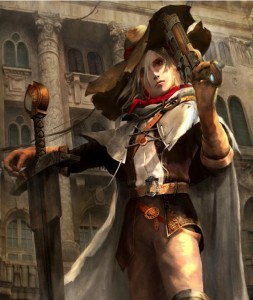 Okay…so my “villain” is actually the group of shadowy figures who terrorized my D20 Modern campaign.
Okay…so my “villain” is actually the group of shadowy figures who terrorized my D20 Modern campaign.
Let me explain a bit of background: I ran a standard D&D 3.5 campaign for almost 2 years. Six players created characters that they used to cajole, torment, intimidate, and fireball the world as they saw fit. They were heroes who sacrificed themselves to save a world who barely knew them, and my players still talk about the characters to this day, though the campaign itself died before finishing due to several factors, most notably an inability to get everyone together. When we elected to end the campaign due to scheduling issues, I asked my players if they wanted their character sheets, or if I could be given permission to utilize the characters in the future. All the players gave their wholehearted agreement to allowing me to keep their characters and to utilize them if I saw fit (I’m pretty sure, since I’m a writer, they assumed I’d be using them as characters in prose).
Fast forward two years. I’ve returned to take my place behind a GM screen, and I start a D20 Modern campaign. My characters learn early on that there’s a world parallel to our own where all our “myths” and “legends” actually dwell. The players are quickly drawn into a conflict that spans both worlds, investigating a string of murders that are targeting residents of the “mythic” world who’ve sought refuge in our own, and they’re seeking out the lost heirs of several races in the mythic world who’d been spirited to our own to protect them from the Shadow Lords, a conglomerate of evil who’ve become obsessed with overtaking not just the mythic world, but our own as well. The players even get excited when they find themselves in a city called Moonhaven, in which their original RPG characters had raised a ruckus in the old campaign (the sheer volume of nostalgia that re-entering Moonhaven generated derailed my gaming session for nearly an hour). Following the trail of the Shadow Lords, the group gather the lost heirs of the kingdoms, manage to gain support on both sides of the veil between worlds, and even befriend a white dragon, who sacrifices himself to ensure that the party is able to continue its mission.
The final showdown begins, and the players once again find themselves in Moonhaven, staring at a statue that immortalizes their former RPG characters. They’re attempting to ascertain the actual location of the Shadow Lords when the bronze statue cracks, the city shakes, and then the town square opens into a large, cavernous pit. Six shadowy figures slowly materialize; one by one, I describe them to the players. And one by one, my players begin to panic.
The Shadow Lords reveal themselves to be the players’ former characters, driven to vengeance upon a world they died to save, but has largely now forgotten them. Each of the villains were actually about 2-3 levels above where the new characters were, level-wise, and the players remembered enough to know it. I’ve never seen so much panic around a gaming table, ever. I found my players torn—torn between knowing that to emerge victorious, they were going to have to slay characters they’d previously loved to play, and the desire to find a way NOT to have to do it. I even had a couple of players begin an attempt at strategic diplomacy—they attempted to join the Shadow Lords to avoid having to kill their former characters. I let them attempt it—after all, if they can succeed, so be it—but that first “natural 1” ended that parley rather quickly.
The characters actually did succeed in vanquishing the Shadow Lords and repairing the rift between the two worlds…and to this day, nearly 3 years later, whenever my gaming group gets together, that battle and those antagonists are STILL a common topic of discussion.
So while my entry isn’t a single, statted-out villain, per sé, the Shadow Lords were one of the most well-received and terrifying (to my players) set of antagonists to ever grace my gaming table. I hope you’ll consider my entry!
